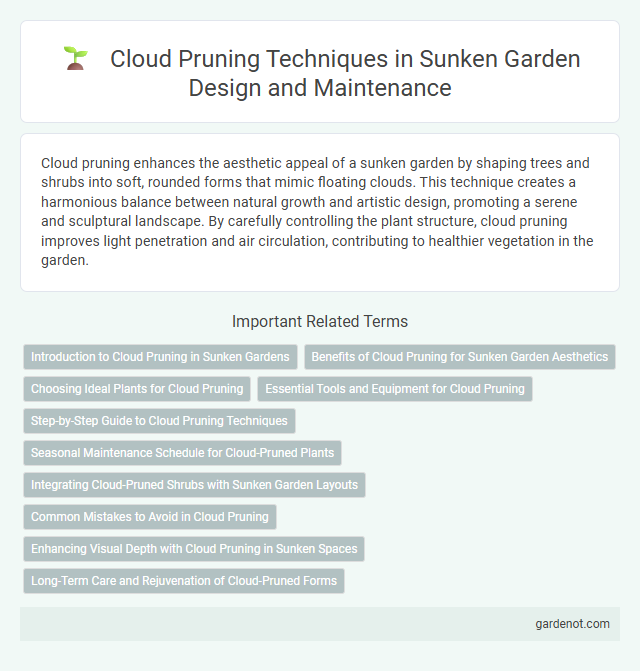Cloud pruning enhances the aesthetic appeal of a sunken garden by shaping trees and shrubs into soft, rounded forms that mimic floating clouds. This technique creates a harmonious balance between natural growth and artistic design, promoting a serene and sculptural landscape. By carefully controlling the plant structure, cloud pruning improves light penetration and air circulation, contributing to healthier vegetation in the garden.
Introduction to Cloud Pruning in Sunken Gardens
Cloud pruning is a specialized horticultural technique used in Sunken Gardens to create sculptural, cloud-like shapes from trees and shrubs. This method enhances the garden's aesthetic by promoting layered foliage and controlled growth, emphasizing balance and harmony within the natural landscape. Expert gardeners typically apply cloud pruning to species such as pines and azaleas to achieve a serene and artistic ambiance.
Benefits of Cloud Pruning for Sunken Garden Aesthetics
Cloud pruning enhances the visual appeal of sunken gardens by creating sculptural, layered plant forms that add depth and dimension to the landscape. This technique improves sunlight penetration and airflow, promoting healthier plant growth and vibrant foliage colors. With its artistic shapes and maintained structure, cloud pruning transforms sunken gardens into serene, harmonious spaces that blend natural beauty with meticulous design.
Choosing Ideal Plants for Cloud Pruning
Selecting ideal plants for cloud pruning involves choosing species with natural, rounded foliage that can be sculpted into layered, cloud-like shapes. Evergreen plants such as Japanese holly (Ilex crenata), boxwood (Buxus sempervirens), and podocarpus (Podocarpus macrophyllus) are popular choices due to their dense growth and ability to maintain form year-round. Proper plant selection ensures vibrant, structured aesthetics in sunken garden designs through effective cloud pruning techniques.
Essential Tools and Equipment for Cloud Pruning
Essential tools for cloud pruning in a sunken garden include sharp bypass pruning shears for precise cuts, pole pruners to reach elevated branches, and hand saws for thicker limbs. Using high-quality, rust-resistant equipment ensures clean cuts that promote healthy plant growth. Protective gloves and safety glasses are also crucial to safeguard against debris and enhance control during pruning.
Step-by-Step Guide to Cloud Pruning Techniques
Cloud pruning involves shaping trees or shrubs into rounded, cloud-like forms by selectively trimming branches to enhance their aesthetic appeal and health. Begin by identifying the main branches and removing any dead or crossing limbs to create a clear structure. Next, trim smaller branches to form distinct, puffy layers resembling clouds, maintaining balance and natural growth patterns throughout the process.
Seasonal Maintenance Schedule for Cloud-Pruned Plants
Seasonal maintenance for cloud-pruned plants involves precise timing and techniques to maintain their sculptural form and health. In spring, focus on removing old growth and thinning branches to encourage new shoots, while summer requires light pruning to retain the cloud shapes and prevent overgrowth. Autumn and winter are ideal for structural pruning, shaping the overall silhouette and preparing the plant for dormancy in the Sunken Garden setting.
Integrating Cloud-Pruned Shrubs with Sunken Garden Layouts
Integrating cloud-pruned shrubs into sunken garden layouts enhances visual depth and structured elegance, creating layered focal points that mimic natural cloud forms. These sculpted shrubs offer balance against the sunken garden's recessed terrain, emphasizing contours and guiding the eye through varied elevation levels. The precise shapes and rhythmic pruning patterns harmonize with water features and stone pathways, amplifying the garden's serene and contemplative atmosphere.
Common Mistakes to Avoid in Cloud Pruning
Overlooking proper branch spacing leads to overcrowded shapes that hinder sunlight penetration and airflow in cloud pruning. Cutting too close to the main branches causes wounds prone to disease and slows healing processes. Neglecting seasonal timing, especially pruning during active growth periods, reduces the aesthetic effect and compromises plant health.
Enhancing Visual Depth with Cloud Pruning in Sunken Spaces
Cloud pruning in sunken gardens strategically sculpts foliage to create layered, fluffy shapes that amplify visual depth and dimensionality. This technique emphasizes the contrast between trimmed clouds and surrounding plants, enhancing the perception of space in confined or recessed areas. The resulting composition draws the eye upward and inward, providing a dynamic, textured experience within otherwise flat landscapes.
Long-Term Care and Rejuvenation of Cloud-Pruned Forms
Cloud pruning in sunken gardens enhances aesthetic appeal by carefully shaping shrubs and trees into rounded, layered forms that mimic floating clouds. Long-term care involves regular maintenance such as precise trimming, disease control, and nutrient management to ensure healthy growth and preserve the distinctive cloud shapes. Rejuvenation of cloud-pruned forms requires strategic cutting back of overgrown branches, promoting vigorous new shoots and restoring the plant's original silhouette for sustained visual impact.
Cloud pruning Infographic

 gardenot.com
gardenot.com